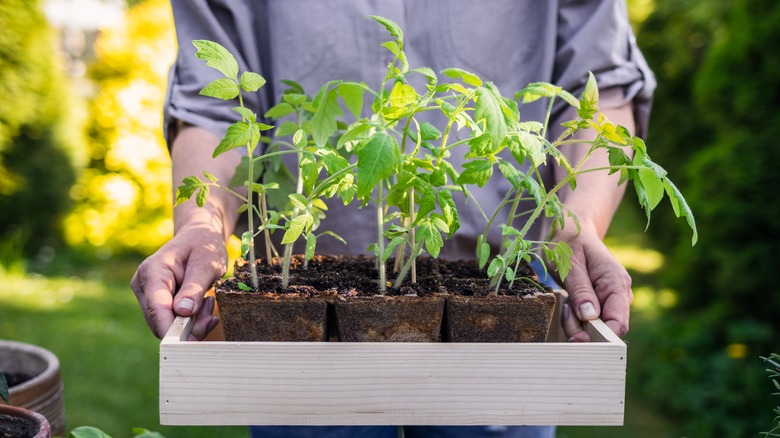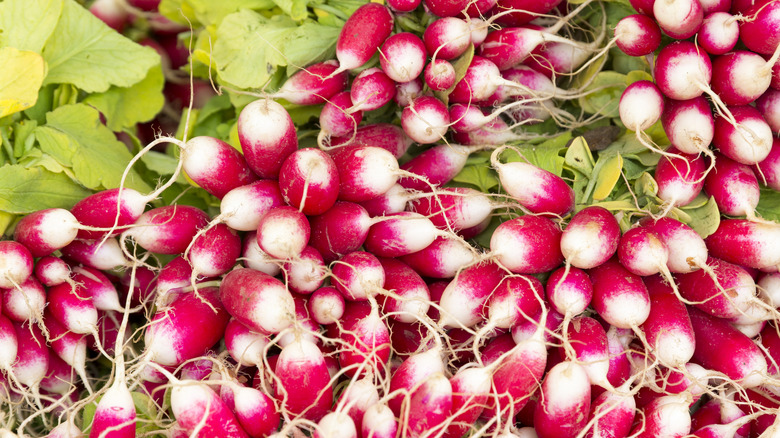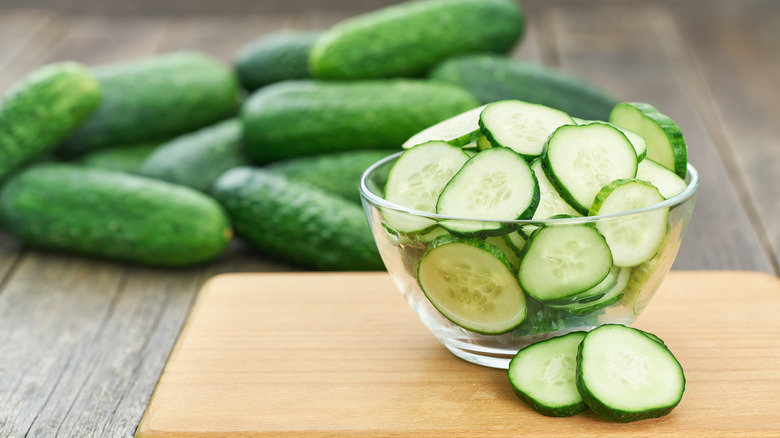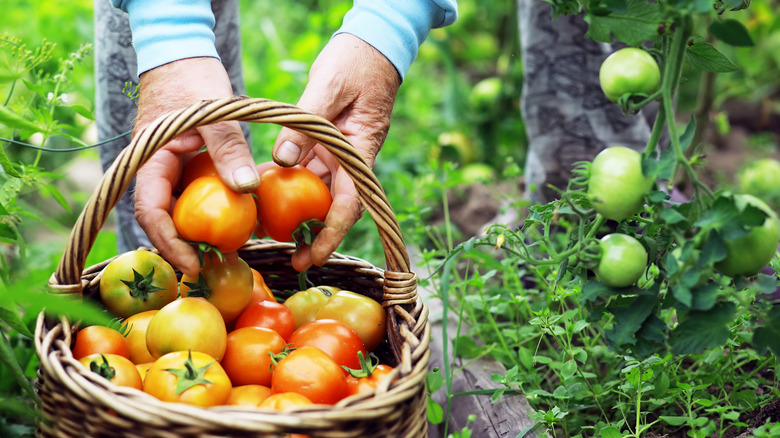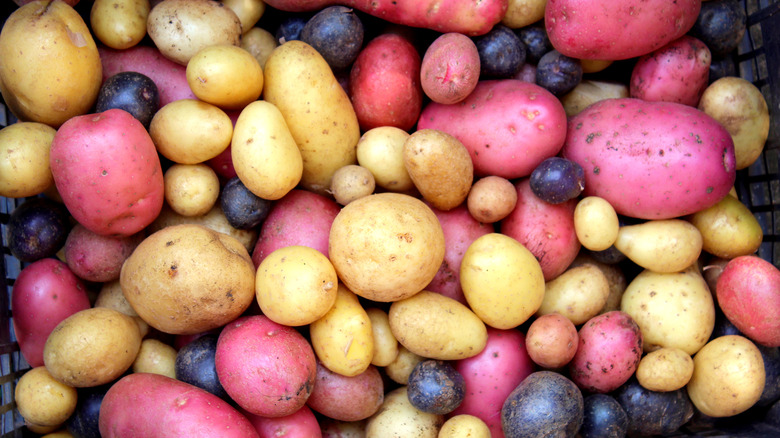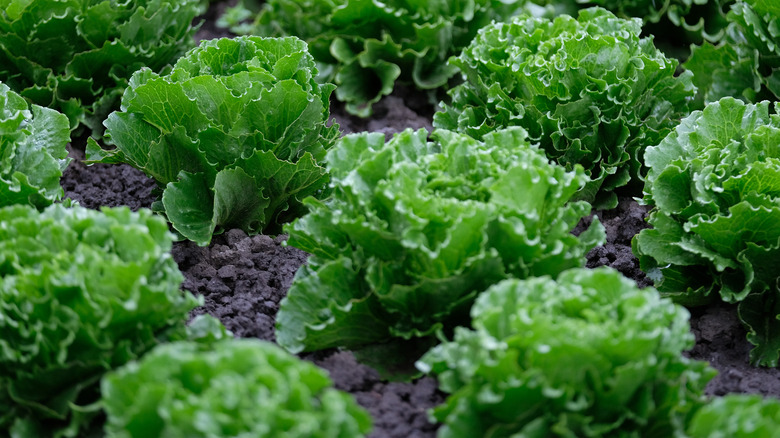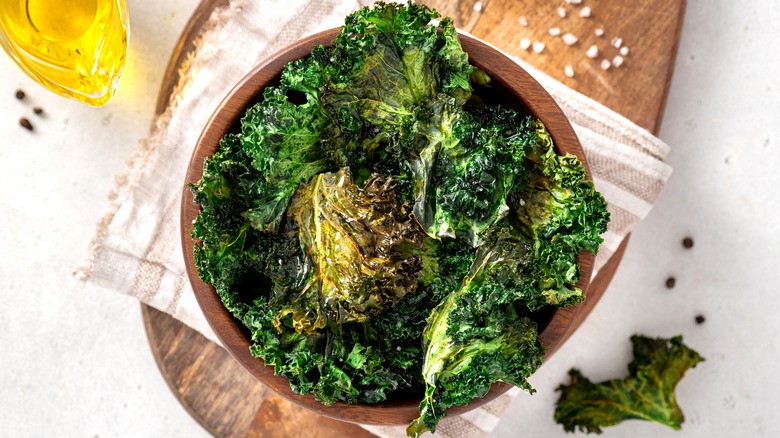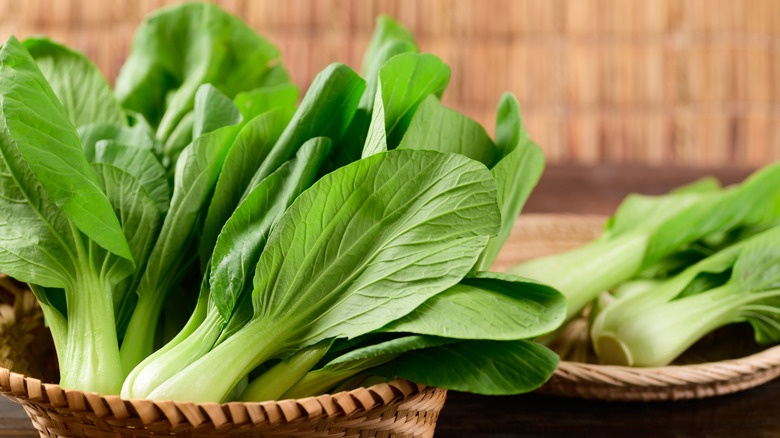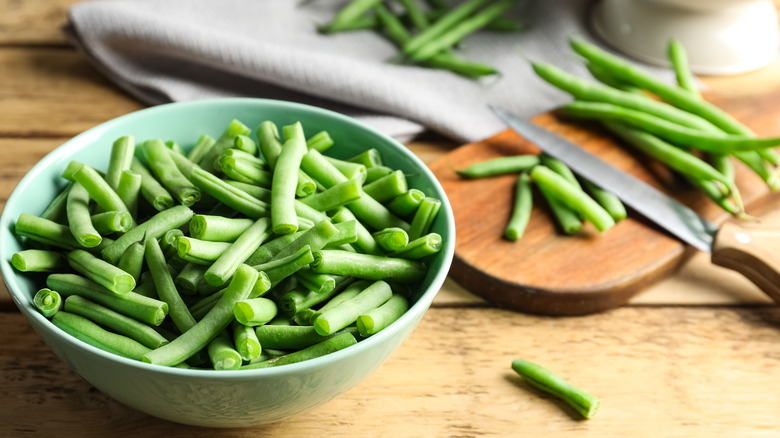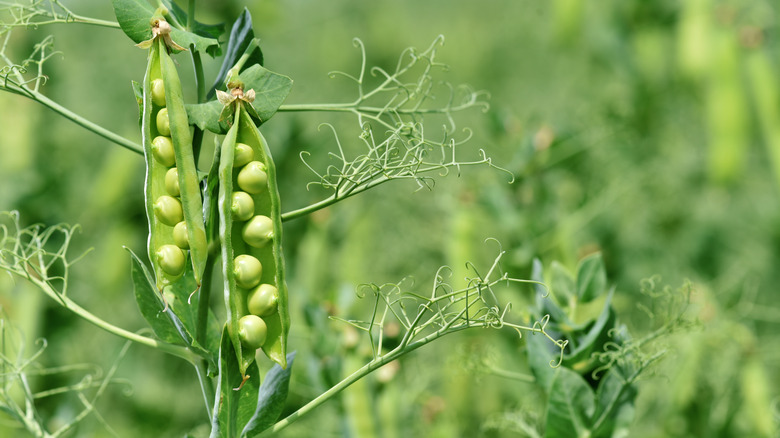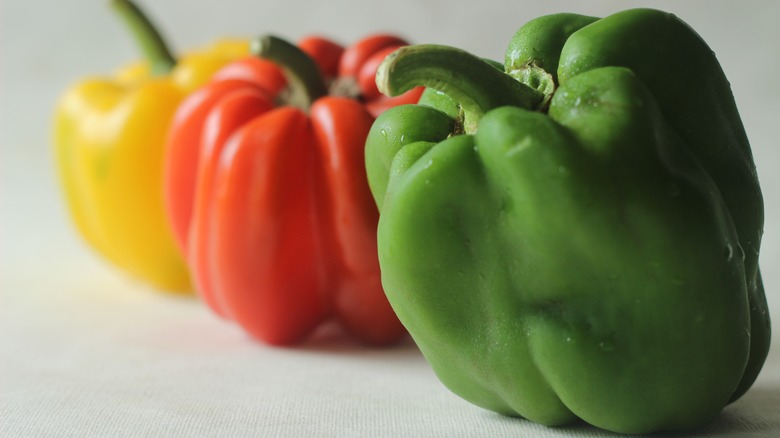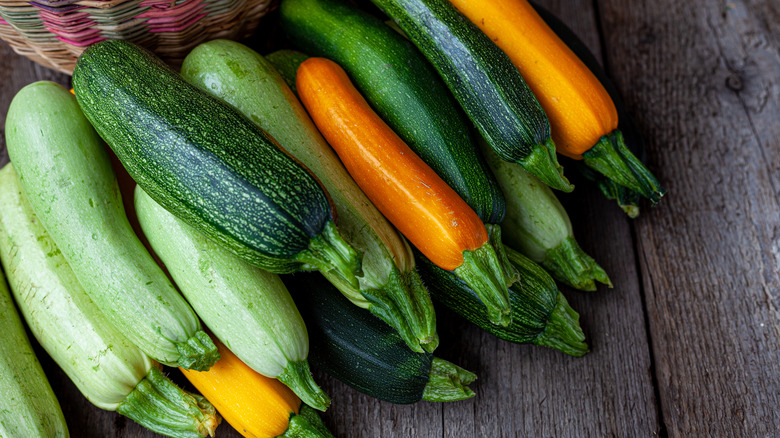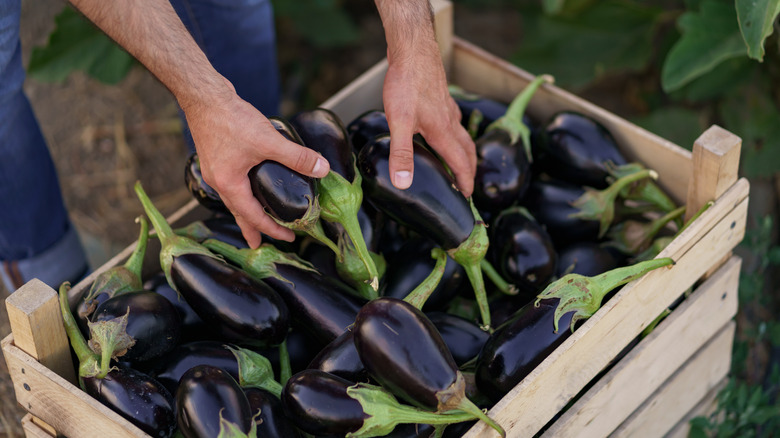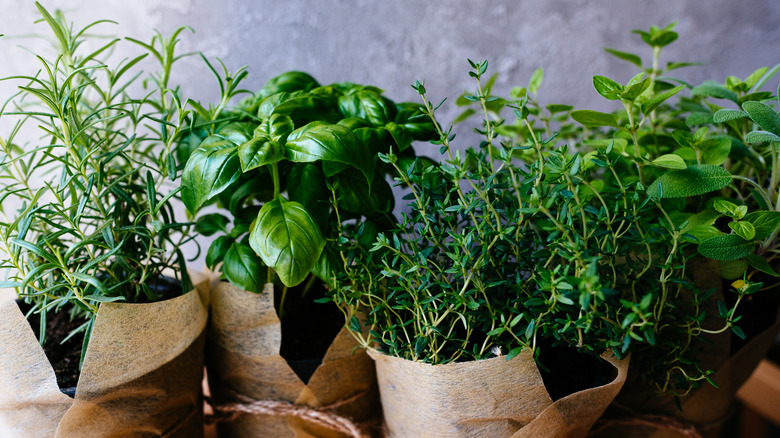The 13 Best Vegetables To Grow If You've Never Gardened Before
Nurturing something and watching it grow can be a rewarding experience. And spending time in nature has been shown to have positive impacts on our physical health and mental well-being. Healthcare centers have been using therapeutic gardening for decades to treat a number of maladies such as high blood pressure, stress, and anxiety. You don't need your own plot of land to start gardening. Many communities have a community garden where members can reserve their own plot to work. There are also a great many vegetables and other plants that can be grown in containers on balconies or patios.
When beginning a garden from scratch, you have a few options. Starting from seed is one option, and it can be done sowing the seeds directly into the ground or in containers indoors, where the proper climate and amount of sunlight are easier to control. When planting outdoors, it helps to know your climate zone and have your soil tested for type, acidity, and possible contaminants, such as lead.
Once you've determined all of this, and you are ready to go, what should you plant? Below we have compiled a list of some of the easiest vegetables to grow for beginning gardeners. Just remember, if you won't eat it, don't grow it!
1. Radishes
Radishes are one of the simplest vegetables you can grow. And they are surprisingly versatile in cooking as well. A raw radish has an almost spicy taste, but when cooked, the flavor becomes milder and sweeter. They are a common pickling vegetable.
There are many varieties of radishes from which to choose. No matter which one you go for, select a spot in your garden with full sun to light shade. Be sure the soil drains well so that your plants do not drown. Radishes tend to grow quickly and can easily be grown from seed. Expect to harvest your crop after as little as four weeks.
Their short maturity time also makes them ideal for container gardening. If properly maintained in temperatures of 40 to 90 degrees, container radishes can be harvested year-round. Longer growing winter varieties are best for storing while the faster growing spring varieties should be eaten fresh.
2. Cucumbers
Though sensitive to cold, cucumbers are another easy-to-grow and versatile vegetable that come in several varieties depending on their intended purpose. The aptly named Boston pickling cucumber, for example, is one of the most popular varieties for pickling. The equally on-the-nose variety Patio Snacker is perfect for snacking on raw or slicing into salads.
There are two formations that cucumbers grow in, vine and bush. The vine varieties may yield more crop, but they require room to spread out across the ground or a structure, like a fence or trellis, to climb. The smaller bush variety is perfect for small gardens or planting in a container.
Because cucumbers can sometimes be sensitive, some believe that growing them in pots is actually the easier way to go. The bush variety is well-suited to container gardening, though certain vining cucumbers (such as the aforementioned Patio Snacker) can also do well in a larger pot with a compact trellis or teepee structure.
3. Tomatoes
Tomatoes are another popular garden vegetable (or fruit, depending on how you view it) that are very productive and come in numerous colors, shapes, and sizes. When the weather has warmed up enough, grown plants can be purchased from local plant nurseries and transplanted into your garden. You can also start seeds indoors while the weather is still too cold for them outside.
Tomatoes are just as productive in a container garden as they are rooted in the ground. Generally speaking, tomato plants love a lot of sun, so be sure to place your pots in a well-lit area such as an uncovered porch or balcony. Bush tomatoes are a solid bet for containers because they only grow to a few feet tall. Vine tomatoes are still possible in a larger pot with the aid of a proper support structure as you would in an in-ground garden.
Protip: You don't need to wait for your red tomatoes to turn that color before harvesting. Just turn those green tomatoes into fried green tomatoes.
4. Potatoes
Potatoes are starchy vegetables that come from seed tubers, which are different from seeds. They look like smaller, hard potatoes, sometimes with clusters of white sprouts, or eyes. One seed tuber can be cut into smaller pieces to create more than one plant as long as each piece contains one (or more) of these sprouts on it.
Unlike the other vegetables mentioned on this list so far, potatoes develop underground. The potato plant itself, which we don't eat, may produce flowers and even fruit. The flowers come in light shades, usually white or pinkish, and are a lovely addition to a garden. The fruit resembles small tomatoes and can produce seeds, but growing potatoes from these seeds is a lengthy process. Using the tubers is an easier and more reliable approach.
After 11 to 14 weeks, you should be able to dig up your potatoes. If they are still small, you can simply put them back into the ground to grow bigger. It's important to keep potatoes out of the sun so that they don't turn green and become unsafe to eat. But don't let that scare you away from trying your hand at this simple, nutritious, and versatile vegetable. They grow well in the ground and in containers.
5. Lettuce
Lettuce is a much-beloved salad green in the United States that is really quite easy to grow yourself. It grows quickly and, depending on the variety, can be harvested as soon as one month from planting. If you are growing them as microgreens, the cultivation time is even quicker. Microgreens grow well in containers and are harvested with a pair of sharp, clean scissors.
The harvesting technique is different for different types of lettuce. Head lettuce, such as iceberg, is cut from the stalk, maintaining its distinct round shape. Leaf lettuce, like butterhead (also called cabbage head due to its resemblance to certain cabbages), is harvested one leaf at a time with garden scissors. By only removing the outer leaves, you allow the inner leaves to continue growing, thus increasing how much lettuce you will get over the course of the season.
Lettuce can be grown in special pots and since lettuce doesn't deal well with frost, growing it in a container that can be brought inside can be quite handy.
6. Kale
Probably the most popular superfood out there is kale. Similar to lettuce, kale is easy to grow and can be used in salads and smoothies, stir-fries, and more. Kale is a robust plant that grows quickly. Its leaves actually taste sweeter after they've been exposed to a light frost.
Sow seeds directly into the soil, or begin them inside and transplant later to make the most of a short growing season. Kale can be grown in pots, but it can also grow to two feet tall, so it should be a large and sturdy pot. Happily, kale grows well in both sun and shade.
Kale is also harvested leaf by leaf, taking the outer leaves and leaving the inner, smaller ones to continue growing. Unlike some other plants, kale will continue producing despite flowering. In fact, the flowers are edible, though they are at their best when still in the bud stage.
7. Bok choy
Because bok choy (also called pak choi) is a cold crop, it can be planted after other crops are done for the season for a fall harvest. You can also plant it in the spring. It is a type of Chinese cabbage whose name is Cantonese for "white vegetable." Bok choy can be eaten raw, cooked, or fermented.
Seed to maturity can be as little as 30 days. The younger the plant, the more tender the leaves. Full maturity is closer to 50 days for most varieties. Similar to other leafy vegetables, individual leaves can be harvested while the plant is allowed to continue growing, but it is common to harvest the entire plant at once by snipping the roots from the base of the plant with a pair of sharp hardening scissors. Leaving a couple of inches of the stem attached may result in the plant regrowing enough leaves to be harvested again later in the season.
It is possible to grow bok choy in containers, but the pots must be between six and 20 inches deep depending on the variety. Baby bok choy (smaller varietals or large varietals picked early) work well in container gardening.
8. Green beans
A common, versatile, and highly nutritious vegetable that is easily grown in a home garden is the green bean. Also sometimes called string beans or snap beans, these beans do come in colors other than green, though green is the most common variety.
There are two main growing styles of green beans: bush and pole. Bush beans can grow up to two feet tall. Pole beans can grow to a dozen feet, give or take, and require a support structure, as the name implies. Pole beans also produce more crop than bush beans do, though they take a week or two longer to reach maturity. Beans need a lot of sunlight to grow, about eight hours a day.
With some extra care, green beans can be grown in pots. As with tomatoes, a special trellis can be obtained for the vines to grow on, or you can plant bush beans, which don't require them.
9. Peas
Peas have a surprisingly long history that dates back as far as 10,000 B.C. They come in two categories, those that are shelled, also called English peas or green peas, and those that are not, when the entire pod is eaten, such as sugar snap peas and snow peas.
Peas are a cool weather crop, but they love sunshine, so a spring planting with a summer harvest is great, though they can also be harvested in the fall. Some pea varieties have been bred to remain small and grow in bushes, but even these peas may need some support structure. Pea plants are at their healthiest when grown with support because most varieties are climbing plants. They are well-suited to container gardening because they can grow on trellises or teepees like pole beans and tomatoes.
Peas are at their tastiest when harvested early while still tender, but not too soon. The best way to tell whether or not your peas are ready to be picked is to taste one. It should be sweet and succulent. Peas allowed to dry on the vine are perfect for adding to soups and stews.
10. Peppers
Both hot and sweet peppers have few maintenance requirements and grow in most hardiness zones. Pepper plants love warmth and sunshine, so starting your seeds inside is not the best idea, or buy fully grown plants from a local plant nursery and transplant them into your garden. They are also generally resilient to harmful bugs, making this a suitable plant for new gardeners who have not yet perfected their pest game. With careful forethought, peppers can be grown in containers.
In order to encourage plants to grow bigger, resulting in larger peppers later, you will want to pinch off the first flower buds. While peppers can be harvested before they are mature, they will be sweeter if you wait until they are fully mature. What flavor you are looking for will determine when you pick your peppers, which you should do with a pair of garden scissors or pruners rather than pulling to avoid hurting the plant.
11. Zucchini
Zucchini, also called a courgette in some regions, has ancestors in the Americas, but it was cultivated in Italy and brought to the U.S. by Italian immigrants. (Zucchini is Italian for "little squash.")
While you can start seeds indoors, you probably shouldn't because the shoots don't transplant well. Sow the seeds directly into the soil once the weather has warmed up, and the danger of frost has passed. Like other squashes, zucchini plants produce both male and female flowers. To ensure a healthy and abundant harvest, you can hand pollinate the female flowers with the males.
Zucchini is a vining plant, and it will spread out. It can be trained to climb a trellis, making it possible to plant in a container. However you choose to grow it, the zucchini fruit should be ready to pick roughly two months after planting. The larger the zucchini grows, the tougher the skin, so picking early while the rind is still tender is ideal.
12. Eggplant
Although most people probably think of the purple variety, eggplants got their English name from the egg-shaped white variety that has been popular in India for centuries. The English learned of it during their occupation of the Indian subcontinent. Eggplants actually come in several colors, shapes, and sizes. But the purple color is so popular that its other common name, aubergine, has come to also mean a specific purple color.
The eggplant is another plant that loves warmth, but that doesn't mean it isn't easy to grow. Seeds can be started indoors, then transplanted into the ground after the last frost. Fully grown plants are, of course, also available at local nurseries. Dwarf varieties can stay in their pots if you don't want, or don't have the space to, transplant them to an in-ground garden.
Eggplants are lovely plants, and many varieties are grown strictly as ornamentals and produce inedible fruit.
13. Herbs
Obviously, herbs are not vegetables, but they are terrific for beginning gardeners and herbs will add wonderful flavors to the dishes you make with the vegetables on this list.
Annual herbs, such as basil, cilantro (also known as coriander), and dill will need to be regrown every year when planted outside in the ground. But if planted in indoor pots, these herbs can last quite a while. Perennial herbs, which come back year after year and will spread when left to their own devices, are plentiful and include catnip (handy for cat owners), chives, oregano, mint, and more.
Rosemary is an evergreen perennial that often does double duty in landscaping. Thyme is another fragrant evergreen that is sometimes used also as a groundcover. These herbs (and others) also attract bees and other pollinators. You just have to be careful with some herbs, like basil and cilantro, because once they have gone to flower, the taste of the leaves changes.
